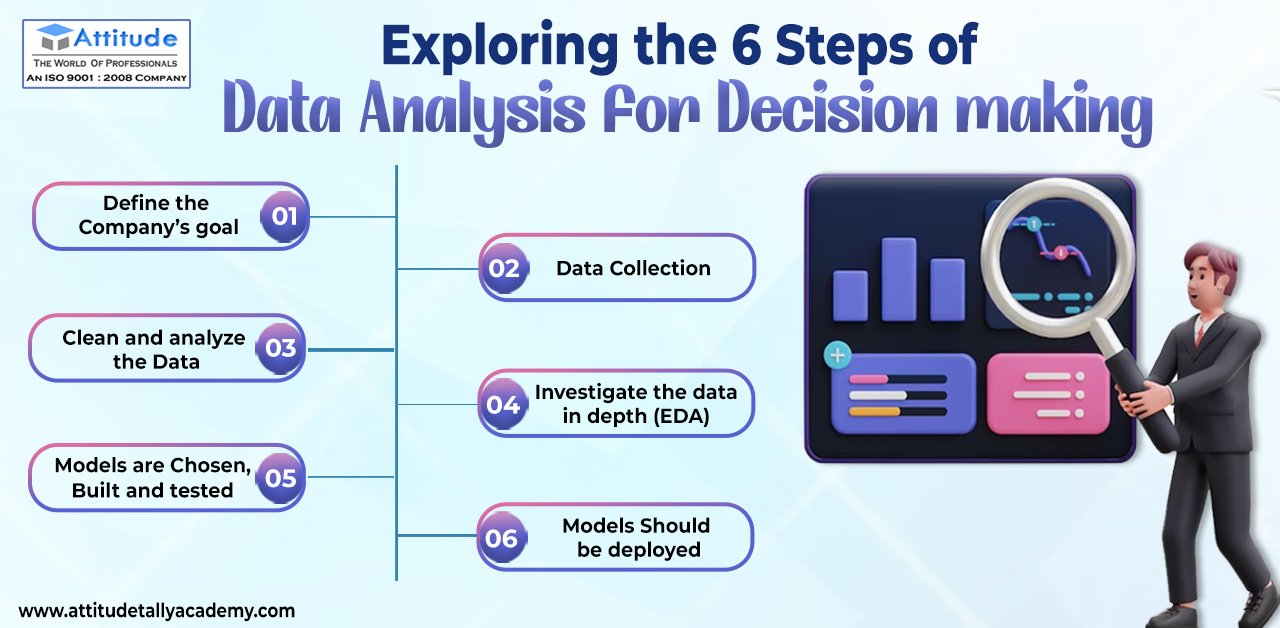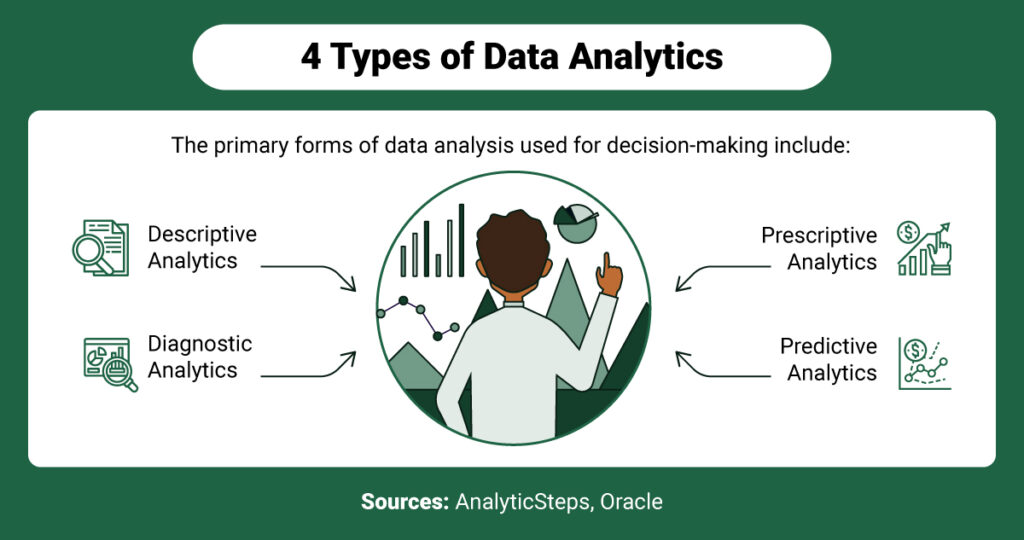Data Analytics in Decision Making: Transforming Business Strategy
In today’s rapidly evolving business environment, data-driven decision making has become an indispensable tool for organizations striving to stay competitive. As companies navigate through massive amounts of information, leveraging data analytics for informed decisions is crucial. By harnessing the power of data, businesses can gain valuable insights, enhance operational efficiency, and optimize their strategies. In this article, we’ll explore the role of data analytics in decision making, the types of data analytics, and how companies can integrate analytics into their decision-making processes.

What is Data Analytics?
Data analytics refers to the process of examining large datasets to uncover hidden patterns, correlations, trends, and insights that can help organizations make better decisions. Through data analysis, businesses can improve operations, enhance customer experiences, and gain a competitive edge.
Data analytics often involves four key types:
- Descriptive Analytics: Describes historical data, offering insights into past events.
- Diagnostic Analytics: Identifies the reasons behind past outcomes.
- Predictive Analytics: Uses data to forecast future outcomes and trends.
- Prescriptive Analytics: Suggests the best course of action based on data.
By analyzing this data, organizations can make informed decisions that lead to better business outcomes, minimizing risks and maximizing opportunities.
The Importance of Data Analytics in Decision Making
1. Improved Decision Quality
Data analytics empowers decision-makers by providing actionable insights backed by data, not assumptions. This leads to more informed decisions that align with actual trends and customer behaviors. Whether it’s optimizing product features, pricing strategies, or marketing campaigns, analytics ensures that decisions are based on solid evidence.
For example, in the e-commerce industry, data analytics can reveal customer buying patterns, enabling businesses to offer personalized recommendations or tailor promotions to specific customer segments. This not only improves customer satisfaction but also boosts sales.
2. Faster Decision-Making Process
In today’s fast-paced business environment, speed is critical. Traditional decision-making processes often involve a lot of guesswork and lengthy deliberation. However, with data analytics tools, decision-makers can quickly access real-time data and get instant feedback on different scenarios.
This rapid access to information allows businesses to make decisions faster, which is essential in today’s competitive landscape. Agility becomes a key advantage when organizations can react quickly to market shifts and customer needs.
3. Risk Management
Data analytics helps businesses assess potential risks before they become problems. By analyzing historical data and monitoring real-time performance metrics, organizations can predict potential risks and take proactive measures to mitigate them.
For example, in the financial sector, predictive analytics can be used to detect fraud patterns, enabling companies to prevent fraudulent transactions before they happen. In industries such as manufacturing, data analysis can predict equipment failures, reducing downtime and preventing costly repairs.
4. Enhanced Customer Insights
Customer behavior is the heart of many business decisions. Data analytics enables organizations to gather deep insights into customer preferences, behaviors, and pain points. By understanding customers at a granular level, businesses can create more targeted marketing campaigns, improve customer service, and develop products that meet customer demands.
For instance, Netflix uses data analytics to analyze user behavior and recommend personalized content, ensuring that users stay engaged with the platform.
5. Optimizing Business Operations
Data analytics helps businesses identify inefficiencies and optimize operations. By analyzing data from various business functions, companies can streamline processes, cut costs, and improve productivity. Whether it’s inventory management, supply chain logistics, or employee performance, analytics provides the tools to make better operational decisions.

How to Integrate Data Analytics into Decision-Making Processes
For businesses to fully benefit from data analytics, it must be integrated into the decision-making process. Below are some effective ways to incorporate data-driven strategies into decision-making:
1. Establish Clear Goals
Before diving into data analysis, organizations should define clear business objectives. Whether it’s increasing sales, improving customer satisfaction, or reducing operational costs, having clear goals will help guide the analytics process and ensure that insights are aligned with business priorities.
2. Collect Relevant Data
To make accurate decisions, businesses need to collect the right data. This includes structured data (e.g., sales numbers, customer demographics) and unstructured data (e.g., social media comments, customer feedback). Ensuring that the data is relevant, accurate, and up-to-date is crucial for obtaining meaningful insights.
3. Invest in Analytics Tools
To maximize the value of data analytics, businesses must invest in the right tools and platforms. Business Intelligence (BI) tools, such as Tableau, Power BI, and Google Analytics, allow decision-makers to easily visualize and interpret data. Additionally, advanced tools for predictive analytics and machine learning can further enhance decision-making capabilities.
4. Foster a Data-Driven Culture
For data analytics to be effective, it must be ingrained in the organization’s culture. This means encouraging teams across departments to use data in their decision-making processes, from marketing and sales to HR and finance. Providing training and support for employees ensures they are equipped with the skills needed to leverage data effectively.
5. Monitor and Refine Analytics Models
Data analytics is not a one-time activity. It’s an ongoing process that requires continuous monitoring and refinement. As more data is gathered and business environments change, analytics models must be updated to reflect new patterns and trends. Regularly reviewing data analysis practices and outcomes ensures that decisions remain relevant and accurate.
Benefits of Data-Driven Decision Making
- Increased Efficiency: By using data to identify trends and patterns, businesses can optimize processes, improving overall efficiency.
- Better Forecasting: Predictive analytics allows businesses to forecast future trends and plan accordingly, leading to more informed and proactive decisions.
- Cost Savings: By reducing inefficiencies and minimizing risks, data-driven decisions help businesses cut costs and improve profitability.
- Enhanced Competitiveness: Organizations that leverage data effectively can identify new opportunities, adapt to changes faster, and stay ahead of competitors.
Real-World Examples of Data Analytics in Decision Making
1. Amazon’s Personalization Engine
Amazon’s success can largely be attributed to its ability to use data analytics to personalize the shopping experience for customers. By analyzing browsing behavior, past purchases, and search history, Amazon’s algorithm recommends products that customers are likely to buy, increasing conversion rates and customer satisfaction.
2. Walmart’s Supply Chain Optimization
Walmart, one of the world’s largest retailers, uses data analytics to optimize its supply chain and ensure that the right products are available at the right time. By analyzing customer purchasing patterns and inventory levels, Walmart can predict demand for products and adjust stock levels accordingly, reducing inventory costs and preventing stockouts.
3. Spotify’s Music Recommendations
Spotify leverages data analytics to understand user preferences and recommend personalized playlists and songs. By analyzing listening habits, demographic data, and even time-of-day usage, Spotify curates playlists that engage users and enhance their experience, keeping them loyal to the platform.
FAQs About Data Analytics in Decision Making
1. How does data analytics improve decision-making?
Data analytics improves decision-making by providing businesses with actionable insights derived from real data. These insights enable decision-makers to base their choices on facts rather than intuition or assumptions.
2. What are the key types of data analytics?
The key types of data analytics are descriptive analytics, diagnostic analytics, predictive analytics, and prescriptive analytics. Each type serves a different purpose in understanding past events, diagnosing problems, predicting future trends, and recommending actions.
3. Can small businesses benefit from data analytics?
Yes, small businesses can benefit from data analytics by using affordable tools that provide insights into customer behavior, sales trends, and operational efficiencies. Even without large datasets, small businesses can leverage analytics for targeted marketing and decision-making.
4. What are the challenges of data-driven decision-making?
Challenges include data quality, privacy concerns, lack of skilled personnel, and the need for proper tools. However, overcoming these challenges can significantly enhance decision-making and business performance.
Conclusion
Data analytics has revolutionized the way businesses make decisions. By leveraging data, organizations can improve decision quality, reduce risks, enhance customer insights, and optimize operations. As we continue to live in an era of constant change and data proliferation, companies that adopt data-driven decision-making will gain a competitive edge and drive business success.
Start using data analytics today to make smarter, faster, and more informed decisions that will propel your business forward.

